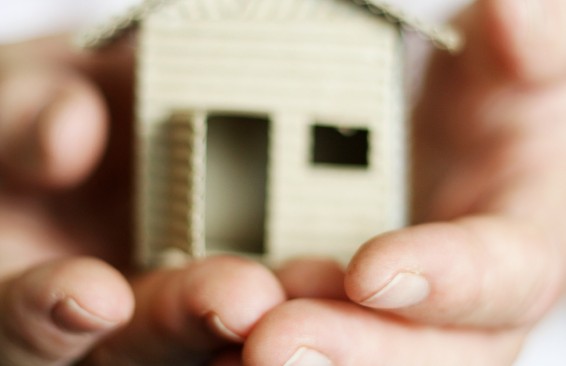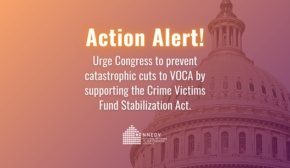The Impact of Safe Housing on Survivors of Domestic Violence
The intersection of domestic violence, homelessness, and housing insecurity is undeniable, as lack of safe and affordable housing is often reported as one of the primary barriers survivors of domestic violence face when they choose to leave an abusive partner. Domestic violence is one of the leading causes of homelessness for women and their children. More than 90% of homeless women experience severe physical or sexual abuse at some point in their lives, and 63% have been victims of domestic or sexual violence.
Although safe housing can provide a pathway to freedom, there are many barriers that prevent survivors from obtaining or maintaining safe and affordable housing. The majority of survivors experience financial abuse, meaning that they have not had access to the family finances, have been prohibited from working, or have had their credit scores destroyed by an abusive partner. Victims may also face discrimination in accessing or maintaining housing based on the violent or criminal actions of perpetrators. Additionally, victims are limited in the locations and types of housing they can access because of their unique safety and confidentiality needs, and many housing or homelessness assistance programs have barriers that inadvertently exclude victims of violence.
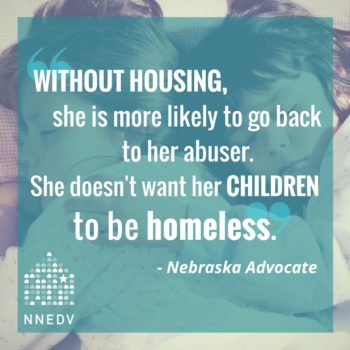
Lack of access to safe, affordable housing creates an additional barrier to safety for survivors.
The National Network to End Domestic Violence (NNEDV) is dedicated to addressing these issues and working to enhance the housing options available to survivors. Through our annual Domestic Violence Counts survey and report, we collect stories and statistics about survivors’ experiences, including their access to safe housing. You will see quotes from advocates throughout this article that were collected through the 11th annual Domestic Violence Counts Report.
“[Through our program], survivors and their children now have the opportunity to settle into a safe environment. Our goal is to empower survivors and secure not only permanent housing, but also their independence.” – Puerto Rico Advocate
The Importance of Collaboration in Systems Advocacy
Survivors face barriers to housing that can be exacerbated by housing systems that do not address their specific needs. In recognition of this fact, NNEDV provides in-depth assistance to states and communities working to transform their housing systems. We are a collaborative partner on the National Domestic Violence and Housing Technical Assistance Consortium, along with the National Resource Center on Domestic Violence (NRCDV), Collaborative Solutions, and the National Alliance for Safe Housing (NASH).
NNEDV and our Consortium partners help to provide training and technical assistance to the domestic violence and homelessness advocacy fields, and we assist in the development of resources that address the intersections of domestic violence, homelessness, and housing. Together, we aim to improve policies, identify promising practices, and strengthen collaborations between housing and homelessness providers, domestic violence service providers, and state and territorial domestic violence coalitions so that survivors will receive supportive, confidential services no matter where they seek them. In addition, we work towards a future with more housing options for survivors.
“Upon receiving the keys to her new home, the survivor was elated and stated, ‘I finally feel free.’” – Ohio Advocate
Improving Service Provision to Survivors in Transitional Housing Programs
While emergency shelters address a survivor’s immediate safety needs, transitional housing provides short-term housing with the same supportive services. It is a safe, affordable option that empowers survivors to begin rebuilding their lives and helps them prepare for permanent housing.
Because of the unique safety needs of survivors, many domestic violence programs across the United States have implemented transitional housing services under three distinct models. A “scattered-site model” secures housing in the community that is rented by the organization or the individual, and the local program pays the rent to the landlord. A “clustered model” houses multiple survivors in one building, with each survivor’s family in their own private unit, typically owned by the local program. Lastly, a “communal model” houses survivors in one building; each individual has their own private bedroom (and sometimes bathroom), but living spaces, such as a kitchen and living room, are shared. Each of these models provide supportive housing, financially and programmatically, for up to 24 months. Transitional housing programs give survivors the time and services they need to achieve goals for long-term safety and stability.
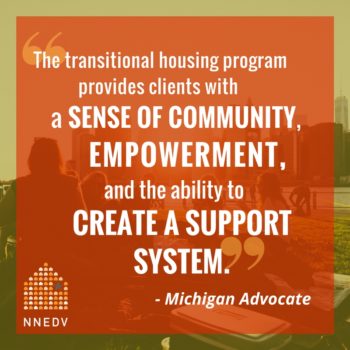
Transitional housing provides survivors with support, community, and empowerment.
NNEDV’s Transitional Housing project provides trainings and intensive technical assistance to more than 200 local programs that provide transitional housing services to survivors of domestic violence, sexual assault, dating violence, and stalking. We help organizations create best practices in housing, transitional housing, and related services for victims, and strengthen programs’ response to victims with an emphasis on survivor-driven, empowerment-based services.
“Our transitional housing program provides survivors with a sense of community, empowerment, and the ability to create a support system.” – Michigan Advocate
Public Policy Reduces the Barriers Between Survivors and Housing
NNEDV works to ensure that the housing needs of domestic violence victims are understood and met through federal housing legislation and federal regulations. NNEDV communicates these shelter, housing, and homelessness needs to policymakers at the national level. We support federal legislation that increases and strengthens housing options for survivors, including the Violence Against Women Act (VAWA). NNEDV continues to work with the federal government to support further guidance and enforcement to improve VAWA’s effectiveness.
A Broad Housing Agenda Increases Options for Survivors
Emergency shelters and longer-term housing are essential for victims of domestic and sexual violence who leave their abusive partners in search of safety.
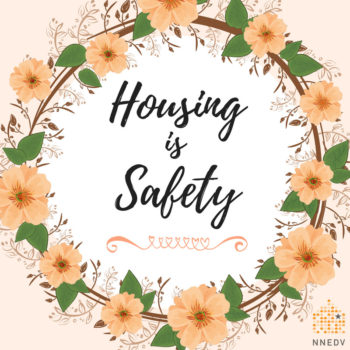
Every home should be a safe home.
We need to promote flexible systems that truly support the courageous survivors who flee violence, increase the availability of affordable housing, and ensure that no survivor is evicted because of the perpetrator’s actions. Solutions must encompass a range of options such as emergency shelter, transitional housing, and permanent housing options, including housing vouchers, mortgage assistance, and federally subsidized housing. Survivors need living-wage jobs, tax credits, access to benefits, and access to childcare, as well as economic literacy, financial education, and job training. We need consistent, stable funding for domestic violence programs that are poised to provide many of these options, alongside housing advocacy and confidential services to help survivors.
“She has moved into her own home, allowing her to be stronger and surer of herself.” – Missouri Advocate
Learn More
- Read about our Housing Policy and sign up for Action Alerts.
- Learn more about Domestic Violence, Housing, and Homelessness.
- Check out the Transitional Housing Toolkit.
- Download our Every Home a Safe Home coloring page.




